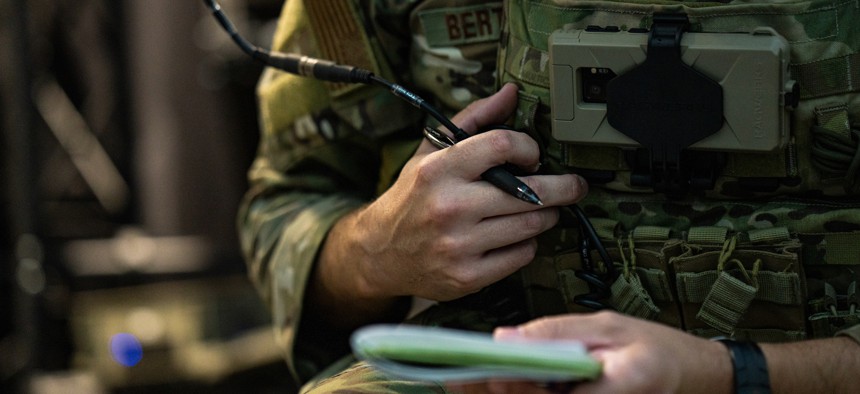
U.S. Air Force Capt. Theodore Bertsch makes radio communications inside the Joint Terminal Attack Controller battlefield dome simulator on Einsiedlerhof Air Station, Germany, June 23, 2021. Capt. Daniel de La Fe
‘It Failed Miserably’: After Wargaming Loss, Joint Chiefs Are Overhauling How the US Military Will Fight
In a fake battle for Taiwan, U.S. forces lost network access almost immediately. Hyten has issued four directives to help change that.
A brutal loss in a wargaming exercise last October convinced the Vice Chairman of the Joint Chiefs Gen. John Hyten to scrap joint warfighting concepts that had guided U.S. military operations for decades.
“Without overstating the issue, it failed miserably. An aggressive red team that had been studying the United States for the last 20 years just ran rings around us. They knew exactly what we're going to do before we did it,” Hyten told an audience Monday at the launch of the Emerging Technologies Institute, an effort by the National Defense Industrial Association industry group to speed military modernization.
The Pentagon would not provide the name of the wargame, which was classified, but a defense official said one of the scenarios revolved around a battle for Taiwan. One key lesson: gathering ships, aircraft, and other forces to concentrate and reinforce each other’s combat power also made them sitting ducks.
“We always aggregate to fight, and aggregate to survive. But in today’s world, with hypersonic missiles, with significant long-range fires coming at us from all domains, if you're aggregated and everybody knows where you are, you're vulnerable,” Hyten said.
Even more critically, the blue team lost access to its networks almost immediately.
“We basically attempted an information-dominance structure, where information was ubiquitous to our forces. Just like it was in the first Gulf War, just like it has been for the last 20 years, just like everybody in the world, including China and Russia, have watched us do for the last 30 years,” Hyten said. “Well, what happens if right from the beginning that information is not available? And that’s the big problem that we faced.”
The October exercise was a test for a new Joint Warfighting Concept. But the new joint concept had been largely based on the same joint operations concepts that had guided forces for decades, Hyten said, and the red team easily defeated them.
After the October loss, the Joint Chiefs began an overhaul and shifted toward a new concept they call “Expanded Maneuver.” Hyten wants the U.S. military to be ready to fight under this overhauled Joint Warfighting Concept by 2030, using many of today’s weapons, aircraft, and ships.
Earlier this month, Hyten released four directives to the services: one each for contested logistics; joint fires; Joint All-Domain Command and Control, or JADC2; and information advantage. On Monday, he revealed new details about these “functional battles.”
Contested logistics. Creating new ways to deliver fuel and supplies to front lines. U.S. Transportation Command and the Air Force are working on using rockets and a space trajectory to get large cargo spaceships into and out of battlefields.
Joint fires: “You have to aggregate to mass fires, but it doesn't have to be a physical aggregation,” Hyten said. “It could be a virtual aggregation for multiple domains; acting at the same time under a single command structure allows the fires to come in on anybody. It allows you to disaggregate to survive.” Hyten said the joint fires concept “is aspirational. It is unbelievably difficult to do.” And the military will have to figure out what part will be affordable and practical, he said.
JADC2: The Pentagon’s push to connect everything demands always-on, hackerproof networks, Hyten said. “The goal is to be fully connected to a combat cloud that has all information that you can access at any time, anyplace,” so that, like with joint fires, the data doesn’t get exposed or hacked because it’s housed in one centralized location, he said.
Information advantage: This element is the sum of the first three, Hyten said: “If we can do the things I just described, the United States and our allies will have an information advantage over anybody that we could possibly face.”
Don't miss:
The new operating concept comes as the U.S. military reshapes its footprint in the Middle East to better prepare for a fight with China. On Monday, President Joe Biden announced U.S. troops will end their combat role in Iraq by the end of the year; the announcement comes just two months after Biden announced a full withdrawal from Afghanistan.
“You've seen it in Afghanistan and you're seeing it play out now in Iraq.” Hyten said. “We have to not ignore the threats in the Middle East, but deal with the threat to the Middle East in a different way, with a smaller footprint, so we can divert more of our body on threats in China and Russia."
NEXT STORY: US Will End Combat Mission In Iraq, Biden Says




